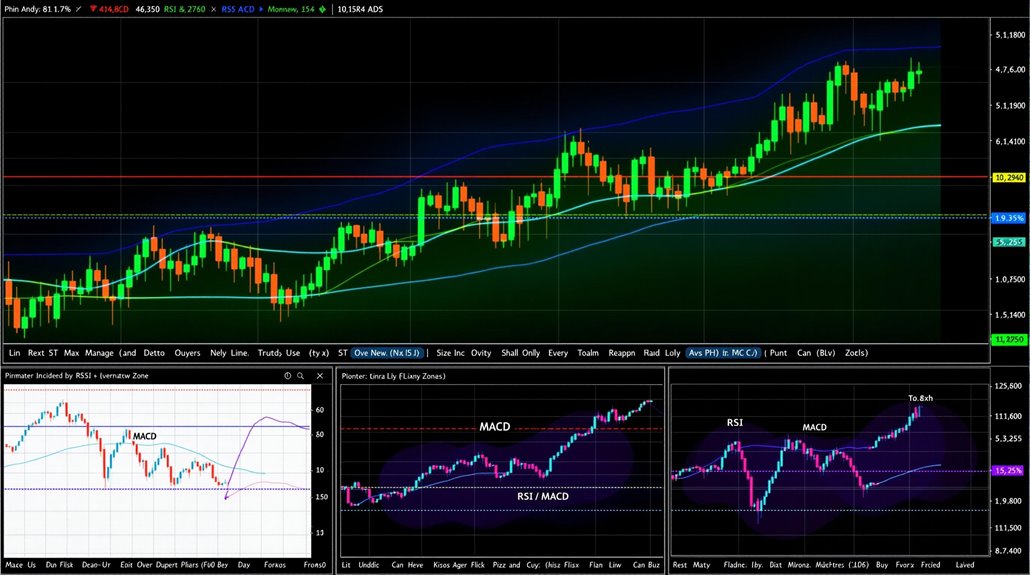Momentum indicators provide systematic methods for identifying ideal market entry and exit points through technical analysis tools like RSI, MACD, and Stochastic Oscillators. These indicators measure price velocity and trend strength by analyzing historical data patterns, with RSI signaling overbought conditions above 70 and oversold conditions below 30, while MACD confirms trend direction through moving average crossovers. Successful implementation requires cross-verification across multiple indicators and timeframes, offering traders a thorough framework to enhance their strategic market timing decisions.
Key Takeaways
- RSI readings below 30 signal potential entry points, while readings above 70 indicate optimal exit zones for momentum trades.
- MACD crossovers provide confirmation of entry and exit signals when aligned with primary momentum indicators.
- Stochastic Oscillator crossovers between %K and %D lines identify overbought and oversold conditions for timing trades.
- Multiple timeframe analysis using 1:4 or 1:6 ratio frameworks helps validate entry and exit signals across different periods.
- Cross-verification of signals using different momentum indicators prevents false entries and confirms genuine market reversals.
Understanding the Core Mechanics of Momentum Trading

While momentum trading has evolved considerably since its inception, the core mechanics remain firmly rooted in the fundamental principle that established market trends tend to persist rather than immediately reverse. This phenomenon aligns with Newtonian physics, where objects in motion maintain their trajectory unless disrupted by external forces.
The strategy’s effectiveness relies heavily on momentum psychology, where market participants’ collective behavior reinforces trend persistence through sustained buying or selling pressure. This self-reinforcing cycle often continues until significant market events or sentiment shifts occur. Traders commonly utilize moving average crossovers to identify optimal entry points in trending markets. Many traders enhance their analysis by monitoring MACD divergences to spot potential trend reversals.
Market momentum feeds on itself, as collective trading behavior creates a self-sustaining cycle of buying or selling until disrupted.
Successful implementation requires:
- Recognition of established trends through technical analysis
- Identification of acceleration points in price movement
- Understanding of volume patterns that confirm momentum
- Precise timing of entry and exit points
The approach demands rigorous discipline and systematic execution, as momentum traders must distinguish between sustained trends and temporary market fluctuations while maintaining strict risk management protocols.
Essential Types of Momentum Indicators Explained
Momentum indicators such as the Relative Strength Index (RSI) and Moving Average Convergence Divergence (MACD) serve as essential technical analysis tools for identifying potential market entry and exit points.
The RSI’s oscillation between 0 and 100 provides vital overbought and oversold signals, while the MACD’s comparison of moving averages reveals momentum shifts through its signal line crossovers and histogram patterns. These indicators are particularly more valuable in bullish markets where trends tend to be more sustained. Failure swing patterns often provide reliable signals for upcoming trend reversals when analyzing RSI movements.
Stochastic trading patterns complement these indicators by measuring price position relative to recent ranges, with readings above 80 and below 20 signaling potential reversal points when confirmed by corresponding RSI or MACD signals.
RSI and MACD Basics
Technical traders rely heavily on two prominent momentum indicators: the Relative Strength Index (RSI) and Moving Average Convergence Divergence (MACD).
These sophisticated analytical tools, when implemented synergistically, provide traders with thorough market timing signals for enhanced decision-making capabilities. RSI performs optimally in trading range markets rather than strongly trending conditions. Understanding divergence patterns can help traders identify potential trend reversals and market turning points.
Key implementation characteristics include:
- RSI applications focus on identifying overbought conditions above 70 and oversold conditions below 30, serving as potential reversal indicators.
- MACD strategies utilize the relationship between short-term and long-term moving averages, with signal line crossovers indicating momentum shifts.
- The convergence of both indicators frequently yields more reliable trading signals than individual indicator analysis.
The mathematical precision of these indicators, developed through rigorous statistical analysis, enables traders to quantify market momentum while maintaining objectivity in their strategic approach to market timing.
Stochastic Trading Patterns
Building upon the foundational concepts of RSI and MACD, stochastic trading patterns represent another sophisticated layer of momentum analysis that traders leverage for precise market timing. The range-bound oscillator helps traders identify overbought and oversold conditions through its 0-100 scale, providing clear entry and exit points.
The patterns manifest through distinct signals, with overbought signals above 80 and oversold conditions below 20 serving as primary reversal indicators. Understanding market psychology helps traders better interpret these reversal signals without relying on complex indicators.
Traders employ crossover strategies when the %K line intersects with the %D signal line, while divergence analysis provides early warnings of potential momentum shifts.
The effectiveness of these patterns varies, with regular divergence yielding 8-12% average price movements and hidden divergence producing 5-8% returns.
Advanced practitioners optimize oscillator settings based on asset volatility and utilize trend confirmation through multiple timeframes to enhance signal reliability.
Success rates reach 65% for overbought signals and 62% for oversold conditions when combined with supplementary technical indicators.
Best Practices for Reading Market Signals

Successful interpretation of momentum indicators requires methodical cross-verification across multiple technical tools to validate potential trade signals and minimize false readings.
Establishing clear, quantifiable entry criteria based on specific indicator configurations helps traders maintain discipline while monitoring divergence patterns between price action and momentum readings. Combining support and resistance analysis with momentum readings provides additional confirmation of potential reversal points.
The systematic analysis of divergence, particularly when confirmed through multiple indicators, provides traders with robust insights into potential trend reversals and ideal entry points for position execution. Implementing an average approach strategy by selecting multiple momentum indicators across different evaluation periods helps reduce risk and maintain consistent profitability even when individual indicators underperform.
Cross-Verify Multiple Indicators
Effective market analysis demands the strategic integration of multiple technical indicators to generate reliable trading signals and minimize false positives. The pursuit of indicator synergy requires careful selection of complementary tools that validate market conditions from different analytical perspectives.
Selecting indicators from different measurement categories helps prevent signal overlap and analysis paralysis. Incorporating volume profile analysis provides crucial insights into market participation levels and potential trend strength.
Key verification strategies include:
- Combining momentum indicators (RSI, MACD) with volume metrics to confirm signal strength and market participation.
- Analyzing signal alignment across multiple timeframes using a 1:4 or 1:6 ratio framework.
- Cross-referencing price action patterns with oscillator readings to identify high-probability trade setups.
Traders must avoid redundant indicators from the same category, instead focusing on diverse measurement tools that provide independent confirmation.
This methodical approach to signal verification enhances decision-making reliability and reduces exposure to false breakouts or premature entries.
Define Clear Entry Rules
While cross-verification of multiple indicators establishes a broad analytical foundation, the implementation of clearly defined entry rules transforms abstract signals into actionable trading decisions.
Successful momentum trading requires systematic entry criteria that eliminate emotional decision-making and strengthen trading discipline.
Effective entry rules incorporate multiple dimensions of market confirmation:
- Volume validation of price movements and momentum signals
- Standardized technical indicator thresholds (RSI, MACD, ADX)
- Alignment with prevailing market trends
- Predefined triggers based on specific indicator readings
- Risk management parameters integrated into entry decisions
These components work together to create a structured framework for market entry, ensuring that trades are executed only when conditions meet predetermined standards.
Moving average crossovers can provide reliable confirmation signals for momentum-based trading strategies.
This systematic approach helps traders maintain objectivity and consistency while filtering out low-probability setups. Recognizing that momentum leads price can provide traders with early signals of potential trend reversals or continuations.
Monitor Divergence Patterns
Monitoring divergence patterns represents one of the most powerful analytical tools for identifying potential market reversals and trend continuations in momentum trading. Effective divergence analysis requires systematic observation of price action against momentum indicators while implementing robust trend confirmation methods. Understanding that divergence signals indicate a higher retracement probability rather than guaranteeing reversals helps traders maintain realistic expectations and adjust positions accordingly.
Traders executing momentum-based strategies should focus on:
- Evaluating both regular and hidden divergences across multiple timeframes to identify high-probability setups that align with prevailing market structure.
- Validating divergence signals through complementary technical indicators, particularly volume analysis and key support/resistance levels.
- Distinguishing between significant swing points and minor fluctuations to avoid misinterpreting temporary price movements as meaningful divergence patterns.
This methodical approach to divergence analysis enables traders to capitalize on emerging opportunities while maintaining disciplined risk management protocols within their trading framework. Combining divergence analysis with Bollinger Squeeze patterns can provide particularly strong confirmation of potential trend reversals during periods of compressed volatility.
Strategies for Optimal Entry and Exit Points

Successfully timing market entries and exits requires a sophisticated understanding of momentum indicators and their strategic application across multiple timeframes.
The integration of RSI, MACD, and multi-timeframe analysis creates a robust framework for identifying ideal entry triggers and exit strategies. When applied correctly, these strategies align with trend-following principles that have historically proven effective in various market conditions.
Maintaining position sizing discipline helps protect capital while maximizing potential returns during strong trending moves.
RSI readings below 30 signal potential entry points, while readings above 70 indicate prudent exit zones. MACD crossovers provide additional confirmation, particularly when the MACD line traverses above the signal line for entries or below for exits.
Multi-timeframe confirmation enhances decision accuracy by aligning signals across different time horizons. Traders enhance outcomes by entering positions when both lower and higher timeframe indicators demonstrate concordant momentum patterns.
The combination of multiple momentum indicators strengthens signal reliability. When RSI, MACD, and Stochastic indicators align simultaneously, they present high-probability entry and exit opportunities, especially when supported by broader trend analysis and technical patterns.
Common Pitfalls and Risk Management
Trading success with momentum indicators requires recognizing and actively mitigating inherent limitations and risks that can undermine even well-structured strategies. Market volatility and rapidly shifting sentiment demand robust signal validation protocols and disciplined execution. The importance of combining tools like RSI and MACD provides more reliable trading signals than using indicators in isolation. Maintaining a clear risk-reward ratio helps traders evaluate potential returns against downside exposure.
Three critical pitfalls traders must address:
- Over-dependence on single indicators, which heightens confirmation bias and compromises indicator reliability.
- Disregard for broader market context when interpreting signals, leading to suboptimal entry timing and exit strategies.
- Emotional trading decisions that override systematic approaches, undermining trading discipline and risk psychology.
Successful momentum trading necessitates developing emotional resilience and implementing thorough risk management protocols. This includes utilizing multiple confirmation sources, maintaining strict position sizing rules, and establishing clear stop-loss levels.
Regular performance assessment and strategy refinement guarantee traders adapt to evolving market conditions while preserving capital through disciplined execution of predefined trading parameters.
Combining Indicators for Enhanced Accuracy
While individual technical indicators provide valuable insights, combining complementary tools creates a more robust analytical framework that enhances signal accuracy and reduces false positives in momentum trading strategies. The integration of diverse indicator types establishes a thorough system of signal validation.
Effective indicator synergy emerges when pairing trend-following tools with momentum measures, such as utilizing Moving Averages alongside MACD for enhanced trend confirmation. Avoiding indicator redundancy helps prevent analysis paralysis and conflicting signals when developing a comprehensive trading approach. Bollinger Bands combined with RSI offer precise entry and exit points by confirming overbought and oversold conditions.
Historical analysis demonstrates that integrated approaches using multiple indicators consistently outperform single-indicator strategies across various market cycles. The combination of momentum indicators with sentiment metrics provides deeper market insights, capturing both quantitative price action and qualitative psychological factors.
Traders must avoid redundancy by selecting truly complementary indicators rather than overlapping tools that measure similar market aspects. This strategic approach optimizes decision-making while maintaining analytical clarity.
Real-World Applications Across Asset Classes
The practical application of momentum indicators varies considerably across major asset classes, with each market exhibiting unique characteristics that influence indicator effectiveness and interpretation.
Real world applications demonstrate distinct asset class strategies across financial markets, with momentum tools requiring customized implementation based on market-specific dynamics.
- Equity markets show robust responses to RSI and MACD signals, particularly during trend reversals, with documented outperformance in trending environments and enhanced returns when combined with volatility filters.
- Fixed income traders leverage momentum indicators to optimize duration exposure and capitalize on rate movements, especially during periods of monetary policy shifts.
- Currency and commodity markets exhibit strong trend persistence characteristics, making momentum indicators particularly effective for capturing sustained price moves, though implementation requires careful consideration of market-specific factors such as liquidity conditions and geopolitical influences.
These varied applications underscore the necessity of adapting momentum strategies to each asset class’s unique characteristics while maintaining disciplined risk management protocols.
Performance Metrics and Success Rates
Momentum indicators perform across different market conditions emerges as a critical consideration for technical analysts and institutional traders, with extensive studies revealing nuanced success rates and performance metrics that vary considerably based on market context.
Overbought and oversold conditions identified through momentum indicators like RSI provide traders with precise entry and exit points that can enhance trading performance.
Empirical data demonstrates that individual indicators like RSI and MACD achieve win rates between 55-60% during trending markets, while success metrics decline dramatically during range-bound conditions.
Technical indicators like RSI and MACD show higher success rates in trending markets but struggle significantly during sideways price action.
Trade evaluation frameworks emphasize the importance of thorough performance assessment through multiple metrics, including win rates, average returns, and risk-adjusted measures like Sharpe ratios.
Importantly, combining multiple momentum indicators enhances overall reliability, improving risk-adjusted returns by 5-10% compared to single-indicator approaches.
Systematic backtesting across major indices reveals that momentum-based strategies can outperform traditional buy-and-hold approaches by 2-4% CAGR, though effectiveness diminishes greatly during periods of heightened volatility or during market regime shifts.
Frequently Asked Questions
How Do Momentum Indicators Perform During Black Swan Market Events?
During black swan events, momentum indicators exhibit markedly reduced reliability and effectiveness.
These technical tools struggle to maintain accuracy amid extreme market volatility, often generating false signals and whipsaws in trading positions.
Research demonstrates that factor returns become nearly random in the month following such events, with only 4 out of 12 major events showing expected negative market returns.
Systemic risks and rapid position unwinding frequently overwhelm traditional momentum-based strategies.
Can Momentum Indicators Be Effectively Programmed Into Automated Trading Systems?
Momentum programming can be effectively integrated into automated trading systems through sophisticated algorithms that process multiple technical indicators simultaneously.
Modern trading platforms enable precise implementation of momentum strategies using advanced programming languages like Python, with libraries specifically designed for financial analysis.
These systems can execute trades automatically based on predefined parameters, though careful optimization and ongoing monitoring remain essential for maintaining strategy performance in varying market conditions.
Which Momentum Indicators Work Best for Cryptocurrency Markets?
Like a skilled surfer reading ocean waves, cryptocurrency traders find the Relative Strength Index (RSI) particularly effective in volatile digital markets.
RSI excels at identifying overbought and oversold conditions, while Moving Averages provide reliable trend confirmation.
Research indicates these indicators perform most effectively when combined with Bollinger Bands, creating a robust framework for capturing crypto market momentum.
This trinity of technical tools offers traders precise entry and exit signals across various timeframes.
How Do Earnings Announcements Affect the Reliability of Momentum Indicators?
Earnings announcements greatly impact momentum indicator reliability through two primary mechanisms.
First, earnings surprises can abruptly disrupt established price trends, causing momentum signals to generate false readings during periods of heightened market volatility.
Second, approximately 41% of momentum premium materializes around earnings dates, making these periods both opportunistic and risky for momentum-based strategies.
The predictive power of momentum indicators typically decreases from 5.7% to 2.9% when accounting for earnings announcement effects.
What Role Does Market Liquidity Play in Momentum Indicator Accuracy?
Market liquidity plays an essential role in momentum indicator accuracy through two primary mechanisms: market depth and trading volume.
Higher liquidity environments enable more reliable momentum signals by reducing price distortions and false readings. Analysis shows momentum profits increase from -0.69% in illiquid markets to 1.09% in liquid conditions, demonstrating the significant impact of liquidity.
Trading volume serves as a key metric for validating momentum signals, while insufficient market depth can lead to misleading indicator readings.
Conclusion
Like a skilled ship captain steering through treacherous waters, successful momentum traders must masterfully integrate multiple technical indicators while remaining vigilant of market conditions. Through disciplined application of momentum analysis, risk management protocols, and strategic timing, traders can effectively identify ideal entry and exit points. However, as markets evolve like shifting tides, continuous education and adaptation of these foundational principles remain essential for sustained trading success.
References
- https://corporatefinanceinstitute.com/resources/career-map/sell-side/capital-markets/momentum-indicators/
- https://forextester.com/blog/momentum-indicators-list
- https://groww.in/p/momentum-indicators
- https://thetradinganalyst.com/momentum-indicators/
- https://stackwealth.in/blog/stocks/what-are-trading-momentum-indicators
- https://www.tastylive.com/concepts-strategies/momentum-trading
- https://www.investopedia.com/trading/introduction-to-momentum-trading/
- https://stockstotrade.com/momentum-trading/
- https://www.fastercapital.com/content/Momentum-Trading–Momentum-and-Scalping–Harnessing-the-Power-of-Speed.html
- https://www.investopedia.com/investing/momentum-and-relative-strength-index/

